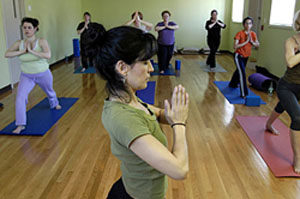In a recent issue of Self magazine, there was an article on the perils of yoga. Namely, that the surge of yoga studios and yoga instructors all over has also sent a few too many yoga practitioners to the doctor’s office or even ER to deal with a pulled hamstring or a slipped disc.
When we think of yoga, most of us think of it as this very soft, mindful and non-combative form of exercise; yet according to the U.S. Consumer Product Safety, nearly 4,500 people ended up in the emergency room after yoga injuries in 2006. When and how did downward dogs and tree pose become so dangerous?
As a yoga practitioner and instructor myself, I consider the problem two-fold. In one corner, you have the student who might be a Type A executive type who has turned to yoga to incorporate a bit more stress relief in her life. But the same personality that pushes them in the corporate world to succeed is also pushing them to lift off into a headstand or touch their nose to their legs in a forward-fold during their first class. I can just hear a left hamstring ripping into small little tears as I write this.
 And in the other corner, is the yoga instructor. For many fitness instructors, keeping their classes filled means keeping abreast on the latest fitness trends and knowing how to teach a yoga class has almost become a marketing necessity for them to stay in business. But… many of the yoga teachers today are doing a quick weekend workshop in yoga, receiving a certificate and declaring themselves as a yoga instructor. Or even more dangerous, there are individuals who don’t have any sort of fitness background and want to go into yoga because there were cutbacks with their service-sector job or want a more fulfilling profession. They take the same weekend yoga training course and are quickly given the responsibility of teaching alignment, breathing and technique to students who may have a host of health conditions or injuries. Scary.
And in the other corner, is the yoga instructor. For many fitness instructors, keeping their classes filled means keeping abreast on the latest fitness trends and knowing how to teach a yoga class has almost become a marketing necessity for them to stay in business. But… many of the yoga teachers today are doing a quick weekend workshop in yoga, receiving a certificate and declaring themselves as a yoga instructor. Or even more dangerous, there are individuals who don’t have any sort of fitness background and want to go into yoga because there were cutbacks with their service-sector job or want a more fulfilling profession. They take the same weekend yoga training course and are quickly given the responsibility of teaching alignment, breathing and technique to students who may have a host of health conditions or injuries. Scary.
I don’t mean to get too hard on all of the yoga instructors out there because there are many brilliant, compassionate, and very learned teachers that have years of instruction and tutelage under their Prana yoga pants. The Yoga Alliance is an organization whose sole purpose is to ensure that individuals who want to become yoga instructors are receiving adequate training and instruction before they are allowed to help someone position themselves in triangle pose. But even this certification falls short because it is voluntary and it only requires about 200 hours of instruction.
My advice, look for a teacher who has real experience. By real experience, I mean, seek out an instructor who has learned a style of yoga from senior teachers, who was a devoted practitioner BEFORE he or she became a teacher and who teaches just one kind of yoga like Ashtanga, Anusara, or Iyengar rather than teaching a combination of different kinds of yoga.
And be nice to yourself. Remember in yoga, you’re not trying to get anywhere. You are no further along your path to enlightenment just because you can stand on your head.
